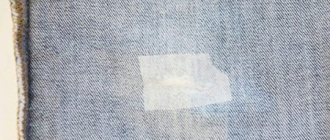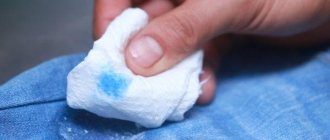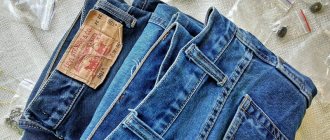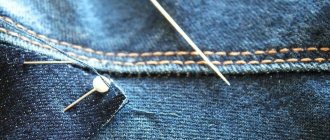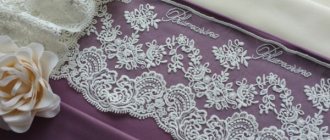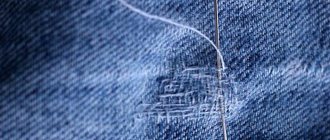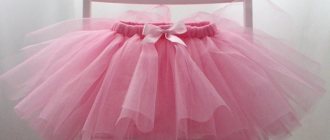From year to year, modern fashion publications show clothing samples that never cease to amaze with their handmade designs. A striking example of inimitable extravagance are ripped jeans.
The question inevitably arises, how difficult is it to turn your ordinary jeans into a fashionable example of perfection at home, for example, like the one in the picture from a glossy magazine?
This is only at first glance; it seems that it is enough to just arm yourself with scissors and make a few chaotic cuts.
The saddest thing is that without special knowledge and skills, if you try to implement something like this yourself at home, your jeans will safely go into the trash. In the best case, as a result of an unsuccessful experiment, denim shorts will remain in the wardrobe.
We strongly recommend that you listen to our practical advice, which describes in detail the steps to transform denim clothing at home. A short instruction will help you understand how to rip jeans beautifully and eliminate possible mistakes in this exciting creative process.
How to choose jeans?
Fashionable slits sometimes give old things a second life. Surely every fashionista has at least one pair of jeans that it’s a shame to throw away, but can no longer be worn. They are perfect for experimentation. If the resulting slits are successful, the old pants will turn into a fashionable new thing.
To break up your jeans, choose a mid-weight model. Very thin and too thick materials will not work: the slots will look ugly.
Ripped jeans with a straight silhouette look most impressive. Too wide or narrowed models are difficult to tear beautifully on your own. Take them on if they are already hopelessly damaged.
The slits look most impressive on classic “denim” colors: light blue and blue. Transverse threads of a light shade create the very contrast that attracts fashionistas in ripped jeans.
Fashionable tight-fitting jeggings or trousers with a high elastane content are unlikely to tear beautifully. The slit will unsightly spread when put on, and there will be no frayed fringe at the edges.
Subtleties of creating abrasions
A detailed master class will help you figure out how to properly give clothes a shabby look and handle this work yourself without leaving home. To perform these actions you will need:
- jeans;
- sandpaper;
- pumice;
- small wooden board.
We do the following:
- Initially, you need to make markings and mark the places where extraordinary decor will be created.
- The board is placed inside the trouser leg exactly under the mark where the abrasion is supposed to be created.
- Using the selected tool, basic manipulations are performed. True, there is no need to make excessive efforts in this case. Otherwise, instead of stylish shabbyness, a sloppy hole will appear on your denim clothes.
When using a grater and pumice, you can get a special effect. The fringe at the edges becomes loose, and in the center there is fraying. Due to this, the image softens a little and becomes somewhat daring. When sandpaper is used, a designer, original wear and tear is created.
After completing these steps, you no longer need to do anything. The decor is well created. True, if desired, clothes can also be decorated with paper clips or rhinestones. It’s better not to decorate men’s jeans at all.
Preparatory work
Ripped jeans look best paired with distressed jeans. Therefore, you will first have to “age” the pants.
Lay the experimental jeans on a flat surface. Place a plastic or any other plate inside the legs so as not to damage the back.
Now you can start rubbing your jeans with sandpaper or pumice stone. Try to avoid the knee area, as the tissue there quickly thins naturally. Artificial aging can lead to the formation of unplanned holes.
General rules
♦ The first rule of cutting jeans is to tear only the part of them that is located on the legs, and not on the pelvis. The fact is that pants with tears at the butt, just like jeans with holes at the knees
, do not look entirely aesthetically pleasing, if not indecent. After all, a normal person will definitely not like to look at your underwear peeking out from the holes (although, a few years ago, torn jeans were considered the clothing of clochards, so who knows...).
♦A rupture in the hip joint, both front and back, is also dangerous in this regard. It is better to make it a little lower, because if you bend or sit down even a little in this outfit, the hole will immediately corrode all the way to the waist. In the upper part of the trousers, the only thing painless would be to use for striping the back pockets, under which there will be a whole fabric, and it will look great.
♦ Now we need to determine at what angle those same white threads go that should remain in our hole =) It seems that all the threads on the denim go diagonally, but in fact, everything is not like that (see photo). If you “fluff” the edge of the denim a little, it immediately becomes clear where the dark threads are, where the light threads are, and what at what angle. On finished jeans you won’t have the opportunity to check this way (unless you need to hem them, for example), but this is not necessary - on all standard normal jeans these treasured white threads run parallel to the floor!
♦Before cutting your jeans, measure the required height and cut location. To do this, put them on and leave marks with tailor's chalk, dry soap or pencil at the height you need.
♦Remove your jeans and lay them out on a flat surface. Examine the material again, try to imagine what you want to get in the end. If necessary, adjust the length of the legs and apply additional markings to the fabric.
♦Next, we make 2 cuts parallel to the white threads, following the markings. We take something with a sharp end (but not too sharp - so as not to damage too much) and begin to carefully pull out the white threads from the cut, so as not to tear it. It is enough to pick up and pull out a few pieces to see a fringe of dark threads running perpendicularly. Now we grab (at first one at a time, then it will be easier to pull straight in bunches) these dark threads and gradually tear them out of our hole! All!
♦ If you want to thin out the white threads, you can do this with scissors afterward. If you want, leave them hanging around the edges or cut them off. This method allows you to achieve exactly what you need and how you need it. The main principle is to pull out the dark threads, remove them according to the shape of the hole!
Therefore, the shape can be any, you just need to think about how and where to make cuts
parallel
to the white threads (otherwise you will cut them and nothing will work). Let's just say that the cuts are needed only to separate some threads from others and pull out what is unnecessary. Therefore, in fact, one small cut is enough - and you can pull out the dark threads from there, cutting them with small scissors according to the intended shape. This is exactly how the heart is made in this photo:
♦As you can see, the cut can be either through or with a backing. In the second case, it is implied that a small piece of fabric will be sewn on the inside, differing in color and texture. Which cut will look best on your jeans is up to you to decide.
♦If the cut is through, simply guide the scissors along the intended contour. You can first cut a smaller piece of fabric to try on the jeans again and evaluate how the item will look in the end.
♦ If you plan to use backing, you will need to cut it out first. The edges of the backing should be about one and a half centimeters larger than the edges of the cutout. Be sure to process the cut with an overlocker or by hand to prevent the fabric from fraying. Then carefully open the outer or inner seam of the jeans, secure the backing with pins and stitch it to the main fabric using a sewing machine. The seam is laid strictly along the pre-designated contour of the cutout. Once the backing is ready, you can beautifully cut the jeans inside the outline and remove excess fabric. Or you can lay a few more lines along the contour, retreating inside the pattern, and make a cut between these lines. Advice:
if you want a heart (or something else of a specific shape), be sure to then glue it (with non-woven material, for example) from the wrong side of the edge or sew it with a zigzag. Or fix it somehow - this is important, otherwise when worn and washed, all the beauty will creep out, the necessary threads will fall out (well, in general, you understand). By the way, you can sew a bright piece of fabric from the inside so that it shines through the hole - for greater beauty :o)
Tip 2:
If you are very afraid of ruining your jeans (or have already ruined them), make the intended hole on a separate piece of denim. Then boldly cut out the desired shape on the jeans with scissors, and place a piece of fabric with the finished hole there from the inside out and sew it on (don’t forget to fix the edges everywhere!).
In the photo on the left, I did just that because I initially made the cuts incorrectly and ruined everything. But even in the photograph it is almost invisible. That's why I drew in red how to sew - close to the edge, you can use a zigzag (I sewed it with a regular straight stitch). source
♦ At fashion shows lately you can see trendy jeans with holes and lace . You can make the same exclusive new things yourself. To do this, you can cover the hole with a guipure ribbon gathered into a ruffle. Or you can hem the lace fabric from the inside under the hole: this way, when moving, the lace will be very tempting to be seen through the hole in the leg, which will make the jeans more romantic.
♦ To prevent it from looking so neat, a fringe is made along the edges . One of the easiest ways to fray the outline of a hole is to wash your jeans in a washing machine. If, again, you don’t have enough time for such manipulations, or maybe you just don’t want to wait long, then there is a simpler way for you. Take a manicure file, or sandpaper, or an iron brush, and use these instruments of torture to torment the cut in your pants.
♦ By the way, you can make gorgeous holes with a small file, sandpaper, a foot rub or a nail file , but this takes a lot of time. We take the pants themselves, stationery knives, fine sandpaper, chlorine bleach, scissors and a lining so as not to cut through all the jeans entirely. Now let's get to work.
Take the jeans, place a lining, pour bleach on the desired area and start rubbing with a sanding knife, but be sure to remember that you shouldn’t do this on the knees, because at the folds they will rub on their own. The aging effect will appear immediately and will delight you for a long time.
You can also do this: pull the pant leg over something round, but not over your leg, because subsequent actions can tear the fabric along with the skin, so it’s better to use a piece of water pipe. Now all that remains is to move the tool back and forth around the circumference of the hole until you get excellent wear and a hole in the center.
♦ If you choose an imitation claw-torn fabric , it will look more civilized and neat, and will also bring to mind grunge.
Types of fashionable slits on jeans
- Noodles - several frequent cross cuts;
- One or more large incisions;
- Shaped cut;
- Small holes , single or many at once.
The slots can be of one type or in combination. Before you begin, first consider the design and shape of the cuts. Do not forget that with wear and washing, the size of the holes and abrasions will increase. Don't make them too big or too close together, otherwise you risk getting one big shapeless hole.
Before starting work, try on the jeans and mark the places of future cuts with a pencil or a dry piece of soap. If your figure is far from ideal, do not make slits in problem areas. Limit yourself to a few small holes in the knee area. Remember that any decor, including slits and fringe, focuses attention on this part of the body.
For slots, the rule of horizontals and verticals works. Thus, vertical holes along the axial threads will visually elongate the legs, and horizontal slits and “noodles” will widen them. Therefore, make such cuts only if you have a slim figure.
Vertical cuts can be made covered with uncut transverse threads. To do this, you need to pull out several longitudinal threads through the slits at the top and bottom. The result will be a fringe effect. Such holes look very modest, since they do not reveal too much of the body, and at the same time impressive.
Irregularly shaped holes
Sloppy rips on the jeans give the look a touch of rebellion and go with street style. The process differs in the way the cuts are created. Rules for getting shapeless holes:
- Make from 5 to 8 transverse slits of different lengths. They are placed one below the other, in accordance with your idea.
- You need to release the white fibers randomly, but in some places you can leave blue threads.
- If you want to increase the size of the hole, then several white threads are removed.
The holes on the fabric can be shaped into a star, heart or any other shape. In this case, you need to place the wrong figure so that the larger diameter of the hole falls on the shared thread, since it stretches less.
Slot technology
So, start creating.
- To make a small hole - a slit, make a cross-section in a verified place with a stationery knife. Try to get strictly between the transverse threads so as not to damage them. Then the fringe will turn out beautiful and even. Now use a needle or tweezers to release the transverse light threads and “ruffle” the longitudinal blue ones. You can further bleach the edges.
Processed with VSCOcam
- To make a vertical slit with fringe, make two parallel horizontal cuts of the desired width at the top and bottom. Grasp the resulting loop with your finger and carefully, using tweezers, pull out all the longitudinal threads.
- If you are going to make several cuts, try on the product after each one. This way you can stop in time if you no longer like the result.
- If you are going to make a large or curly cut, you will need to additionally reinforce the edges with non-woven fabric. This is necessary to keep the shape better. The same should be done for very wide cuts, for example, on the knee (in this case, interlining will be needed in the corners of the slot).
Marking
Trying on jeans will help determine the locations for future slits. Put the product on and mark the fabric with chalk. The sizes of the holes can vary: from microscopic to solid. The more slits are placed on denim pants, the more informal they will look.
After organizing the markings, you need to hang the denim pants on hangers and look at them from a distance. This will allow you to evaluate what effect will be obtained after further processing of the denim.
How can you cut jeans beautifully?
When a trend that was forgotten by everyone for a while returns, its new success always eclipses the previous one. The last time the hype around ripped jeans flared up was in the late nineties and early 2000s. He slept quickly, and some did not have time to dare to purchase a strange new product. A couple of years ago, designers remembered this stylish move, and since then, almost every new collection has a place for artificially aged and cut-up jeans.
The stores offer a large selection of trendy pants. But turning ordinary denim trousers into trendy ones is much more interesting on your own. Moreover, it is very simple! We'll tell you how to cut jeans beautifully.
What to wear with jeans with holes
But holey jeans are not so simple. They require the right combination with other things in the wardrobe.
- So for torn jeans with slits and holes, plain T-shirts, simple-cut shirts and ballet flats are perfect.
- The top should be chosen simple , which will help avoid excessive clumsiness and clutter in the image.
- But if the jeans have a minimal number of cuts, then the top can be colorful and bright .
- In summer, ripped jeans are always appropriate and cute when paired with a bright T-shirt and sports shoes.
- To add more glamor to your look, you can choose more formal shoes , such as beautiful boots or stylish high-heeled shoes.
- Pumps and a peplum top would be appropriate with jeans.
- throw a jacket over your shoulders , which will help you look more stylish and sexy.
Just don't let them be boring and office-like
- A satin blouse, a floral blouse, a denim blouse and feminine shoes will help you create a romantic feminine look This will give the image a flirtatious and slightly relaxed look.
- In winter, for a more sexy look, you can wear a short sweater or a cozy long tunic.
- Youth and optimism will be emphasized by pink and lilac colors in the wardrobe as an addition to ripped jeans.
- Don't forget about accessories: long romantic beads, cute earrings, a scarf or a stylish belt will help create a complete look.
When choosing what to wear with jeans with holes, you need to remember the inconvenience and discomfort that their overly open areas can cause. Therefore, the jeans themselves need to be selected with a small number of tears and slits.
- A stylish sports jacket will go well with these ripped pants . You can wear a blouse with a lot of buttons and throw a jumper on top, or you can choose a cardigan with a beautiful bright top.
- For light jeans, a dark-colored shirt is suitable, and for dark ones, a light blouse.
- It is advisable to choose shoes with platforms or high heels. Shoes with an open toe will soften the look and make it more feminine and graceful.
- Jeans with holes go surprisingly well with almost classic shoes.
- Sports boots or ankle boots look good with jeans with holes. High-heeled boots will also work.
| |
A self-confident, optimistic woman, even in accidentally torn jeans, will look as if this hole is the fruit of the creation of the best couturiers.
Therefore, enjoy your outfits, and then you will inevitably become the most stylish and beautiful!
Which jeans are best for making cuts?
In this matter, two factors are important - the style and material of the jeans. The first one is determined quite easily.
Choose a model that will fit you perfectly and highlight all the advantages of your figure. At the same time, the pants should not be too loose.
It is also unacceptable for them to be tight and literally bursting at the seams.
With the choice of fabric the situation is more serious. Not every jeans with rips looks or wears equally well. There are fabrics that absolutely cannot be “shredded”. For example, those made from fleece.
This option will not look aesthetically pleasing, and during the first wash, the fabric in the area of the cuts will spread in all directions.
You should opt for medium-density fabrics. It can be “dry denim” (Raw denim) or “gin” denim material.
If your goal is to give a second life to old, worn-out jeans, then, of course, you won’t have a choice here. Experiment with what you have.
Try making small cuts and see how they look when worn and how they change after washing. And if all goes well, you will be lucky: instead of a discarded pair of old trousers, you will receive an updated and trendy item.
We consolidate the effect
After the colored shell of the fabric has been erased, the deformed edges should be treated with a piece of pumice. Using rotating movements, treat the entire area of the edges of the formed abrasions.
As a result of this procedure, the threads at the edges will receive additional volume. In addition, pumice will allow you to make a smooth transition of color, which will visually look like a whitened effect.
You can make characteristic gaps in the white warp threads, but you should not cut them off completely. For example, to add even more style, you can cut several threads of the base in the center. Here we can recommend cutting off the resulting strands, leaving about one centimeter of their length, and then, taking a pumice stone in your hands, fluff the threads.
This will add additional volume to the structure and prevent further unraveling of the fabric even after repeated washing.
How to make cuts correctly?
There are several simple, but very important nuances that will help you make the right cuts on your jeans:
- To make perfect cuts, arm yourself with a utility knife. It, unlike scissors or a kitchen knife, guarantees accuracy and ease of the process.
- Before you start making cuts and holes, place a metal or wooden strip (for example, a wide ruler) under the “operated” side of the pant leg. This will protect the back of the pant leg from unwanted damage.
- Cut exclusively in a horizontal direction. This is important because any denim fabric is loose in its weave structure. If you cut at an angle, you risk losing control of the decorative element you are making. It may turn out completely different from what you want.
Decorating the result
How to make ripped jeans at home so that they look bright and unusual? It is worth using decorating methods. The main thing is not to overdo it and not make the style too clumsy.
- You can decorate your pants with lace by sewing a piece of guipure of the required cut on the inside.
- Embroidery combines favorably with the slits on the pants, filling the image with new colors. It works best if one pant leg is torn and the other is decorated with embroidery.
- Using beads to complement your look, you can create a unique style by decorating the cuffs of your pants or the area around the holes made with a scattering of small beads.
- How to make fashionable ripped jeans using rivets? It is enough to stock up on the required number of metal elements and insert them into the required places on the jeans. A half-torn pocket looks impressive, from under which a piece decorated with rivets peeks out.
- Using patches from a different denim fabric or a completely different material, you can achieve amazing effects by sewing the patch not on top, but from the inside of the denim product.
It’s worth seeing what women’s hand-made ripped jeans look like in the photo.
In conclusion, I would like to recommend planning the length of the incision a few centimeters less. During operation, the dissected area of the tissue is stretched 1.5 times.
Having the desire and a developed sense of style, you can create a unique author’s image with your own hands and catch the admiration of others.
© 2021 textiletrend.ru
How to properly rip jeans at the knees?
To create stylish knee holes, you will also need the following tools:
- clothes brush with hard bristles;
- nail file (metal), maybe a small file;
- thin sheet of sandpaper;
- pumice stone or a fine kitchen grater.
All this equipment will help you easily achieve the effect of antiquity. Holes made with it will look stylish and original. When all the tools are prepared, you can get down to business!
Scuffs or aging effects
To give jeans an aged look, use an abrasive material (pumice, file, sandpaper, brush, grater). To create severe abrasions, you will need a metal float, razor or blade. Pumice gives a more modest result. Fine sandpaper will help to gently age the fabric. Before rubbing, the fabric is moistened. If you don't want to make a hole, you should try to preserve the white threads. Therefore, it is worth checking the result from time to time.
To achieve the effect of natural wear, jeans are placed in a bathtub and soaped. Then be patient and rub the fabric for a long time with a brush.
The chlorine contained in “Whiteness” will help to age denim. The solution is applied with a sponge and left for several hours before washing. But you should not overdo it with the chemical, so as not to ruin your jeans. You can simply run a sponge soaked in the product over the created abrasions.
From old to new - making stylish jeans, master class
The page contains a master class on creating stylish clothes for everyday wear.
First, decide where exactly you want to make the cuts. To do this, you can make small sketches on denim using a pencil or soap. The main thing to remember is that the more your jeans are cut, the more attention they will attract, and, therefore, it must look beautiful and stylish. It is also worth knowing that well-placed accents using cuts can significantly change your figure for the better.
Be sure to select the most correct model of product in order to cut jeans. In no case should they dangle on you or be too large. Choose jeans that fit you perfectly even without slits.
Now let's talk about how to beautifully cut jeans with your own hands. Once you have decided on the model of jeans and the cuts on them, hang them on a hanger and carefully, using a chalk, mark the cut lines. Then be sure to consider the future decor from a short distance. This will help identify its shortcomings and note its advantages. To create the most correct composition, try on your product and see how they look on you with cuts. To make your cut-up jeans look like a model from the cover of a glossy magazine, you can use a few tools. You can easily find these accessories at home. Typically, sewing scissors are used to cut denim. But, to obtain the most effective decor, you need to use the most ordinary stationery knife. Make sure that its blade is well sharpened, otherwise you may end up with sloppy cuts that will only spoil the appearance of the product. This is an important point, otherwise you won't be able to cut your jeans beautifully.
Tearing on the knee
In general, after the places for abrasions have been identified, for example, on the knees, you should put the jeans on yourself and, armed with a grater, begin to make characteristic movements in the direction of the base of the fabric. Here, as in the situation with cuts, it is necessary to maintain the integrity of the white warp threads, damaging only the colored (outer) shell of the fabric with a grater.
To make the scuff look beautiful, you should make measured horizontal movements with a grater, without resorting to brute physical force. Remember that vertical movements cannot be made!
As a rule, as a result of the procedure, places may appear that were unsuccessfully grated. In this case, it is possible to correct a visual defect using a regular crochet hook.
Where are the holes made?
The most popular place for cuts and holes on jeans is the knee area. Scuffs from the knee to mid-thigh also look good. There are also interesting options for the entire length of the trouser leg.
But in this case, neat cuts look most advantageous. As a rule, the front part of the trouser leg has holes.
Fans of extreme style will like the option with a cut out fragment. It can be done on one of the trouser legs.
The location is selected individually, depending on your desire. As well as the shape, which can be standard (rectangular, square), or maybe unusual (heart, flower, star).
To mark the locations of future holes and cuts on the jeans, they need to be placed on a hanger. When the pants are in a suspended state, you should make marks on them with chalk or soap (on white jeans you can use a soft pencil). Mark the lines of future cuts carefully, with thin strokes.
If you plan to make several cuts, calculate the distance between them so that they are 2-3 centimeters from each other. When the marks are made, evaluate the picture from the outside.
To finally make sure that the planned fashionable touches will be in place, you need to try on jeans with these sketches. You can try to outline different options and compare them. After several fittings, you can confidently choose the optimal number and location of holes on your jeans.
Take these tools:
- stationery knife (or scalpel);
- pencil (pen or chalk);
- a piece of pumice;
- cardboard.
Advice. You can even draw on fabric with a marker. Once the abrasions are created, it will not be visible on the threads. Also, pre-glue the edges of the cardboard with bright paper so that you can see its cut. You can use sandpaper instead of pumice.
